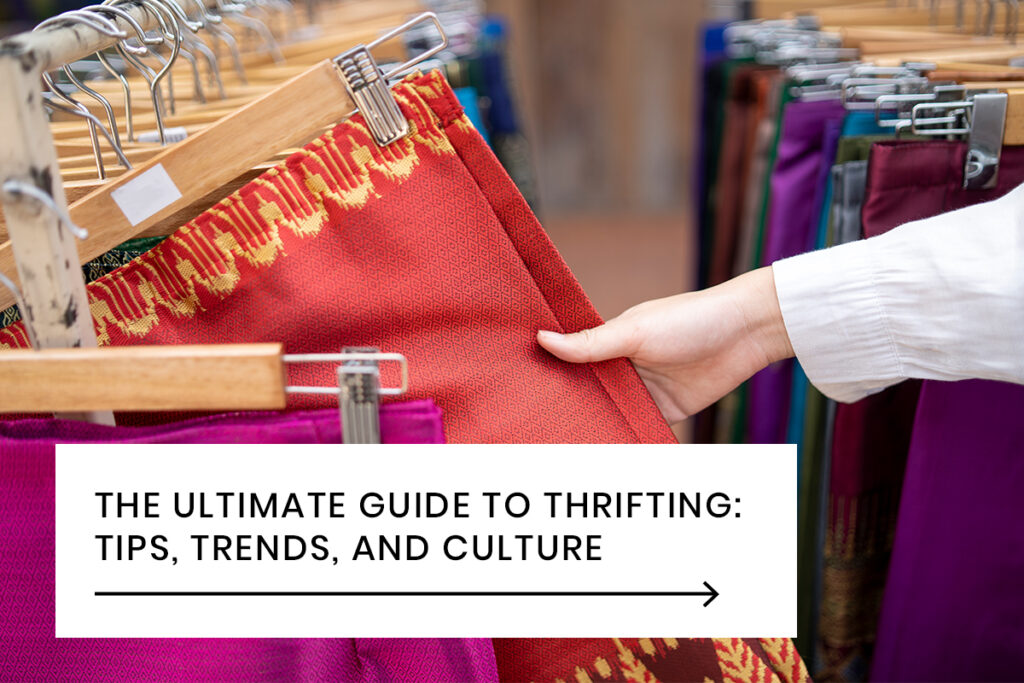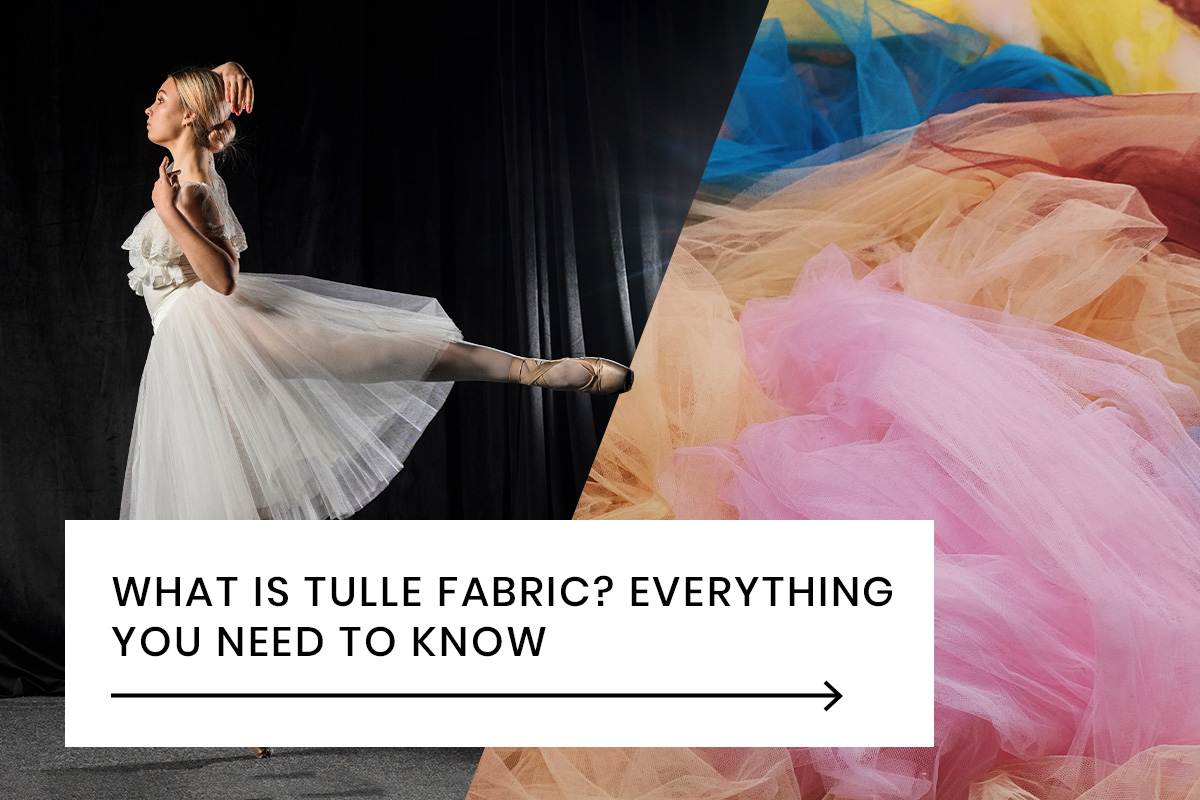Introduction:
With increased awareness regarding the impact of fast fashion – including waste, pollution, and exploitation- people are looking for alternatives to align with their values. So, where does thrifting fit in? Purchasing secondhand clothing and accessories doesn’t just make fashion more affordable while reducing waste by giving life to pre-loved garments; thrifting offers ethical and environmental awareness that simply didn’t exist before.

Thrifting is also more than just a financially conscious act-it has become a cultural shift that integrates personal style with ethicality and environmental accountability.
In this article, we will explore how thrifting is fundamentally changing the fabric of fashion, the environmental and social sustainability benefits of thrifting, and why thrifting is taking center stage in sustainable style.
What is Thrifting?
Thrifting, or thrift shopping, is the act of buying once-used or loved items, which mostly means clothes, accessories, and fashion items. It can either be excess that has been discarded by fast-fashion brands or old, used products that are upcycled/recycled by thrift stores. A significant reason the thrift culture is proliferating at a fast pace is that consumers can access brand-name clothing or items at a fraction of the regular retail price. But are consumers doing thrifting simply because it saves a buck? Absolutely not! Thrifting has a lot to do with the environment.

The History of Thrifting
Thrift shopping today has transformed from its humble beginnings into a global phenomenon. While thrifting used to be solely about low-cost living and necessity, it has shifted into a lifestyle that embraces sustainability, creativity, and minimizing waste. But how did thrifting develop into such a cultural force?
Bartering, as well as dragging clothing and repurposing textiles, can be traced back to ancient history, but modern thrift shops wrongly emerged in the 19th century in Europe and the USA. During this time, charity organizations began to build thrift stores as a method to sell low-cost clothing and essential items to help people in need.
The Thrift Movement:
By the late 1800s and into the 1900s, thrift stores were representative of certain American values, like frugality, practicality, and resourcefulness–most notably during times of economic hardship, like the Great Depression. Organizing donations into charities made thrift shops more commonplace.
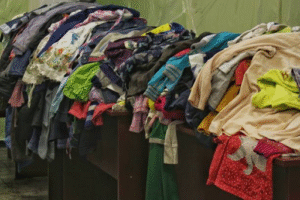
World War II:
Because of rationing, new clothing production was limited. People relied heavily on the use of thrifted, mended, and reused clothing to prolong the article’s life, sometimes in the form of donated clothing from family members.
1960s-70s Counterculture:
During this time, thrift stores became hubs for individualism. People could adopt the hippie or bohemian aesthetics through thrifted finds, opposing original fashion or labels.
1980s-90s Mainstreaming:
The rise of celebrities and fashion icons’ thrifting brought secondhand styles to the forefront of contemporary trends. Thrift stores maintained their essence but became more curated to reach a broader customer base.
The Digital Revolution:
The convenience of online thrift shopping through eBay and Etsy has made thrift shopping more accessible than ever, as well as a global form of shopping for everyone.
Sustainability Takes a Front Seat: As awareness of the ecological impact of fashion increases, and as thrifting becomes a key part of sustainable fashion, it reduces waste and promotes circular consumption.
Today’s Thrift Culture:
Social media and influencers have been the driving force behind the rise of thrifting. It’s not simply about the ‘thrill of the hunt,’ seeking out unique items, but also about serving as a symbol of supporting mindful living.
The difference between thrifting and regular shopping
| Aspect | Thrifting | Regular Shopping |
| Source of Products | Secondhand or pre-owned items from donations, consignments, or vintage collections. | Brand-new items produced and sold by retailers or brands. |
| Price & Value | Usually cheaper; allows access to branded or vintage pieces at low cost. | Higher prices reflect production costs, brand value, and retail markups. |
| Environmental Impact | Sustainability reduces waste, reuses clothing, and lowers demand for fast fashion. | Higher environmental footprint drives new production, often linked to pollution and overconsumption. |
| Shopping Experience | A treasure hunt with unique, one-of-a-kind finds; every trip is different. | Standardized mass-produced collections; predictable inventory. |
| Social & Cultural Appeal | Seen as creative, sustainable, and a lifestyle choice promoting individuality. | Seen as mainstream, convenient, and trend-driven. |
Why people thrift: affordability, sustainability, and uniqueness
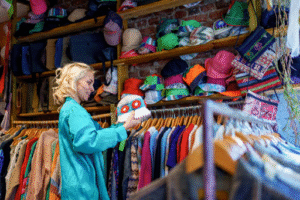
Thrifting has really taken off with millennials (those born between 1981 and 1996) and Gen Z (those born between 1997 and 2012). Here are a few reasons why.
- Affordability: As young adults begin to move away from being financially supported by family, many are finding good, affordable clothing and accessories at a mere fraction of the retail prices.
- Sustainability: Thrifting helps to keep textiles out of landfill waste, as well as pollution caused by making new fashion; eco-conscious youths want to support sustainable fashion.
- Support Charities: Many thrift shops are owned and operated through charities, which means not only does thrift shopping support your social cause, but it also gives a second (or maybe third or fourth) life to a previously unused item.
- Explore Creativity: Because thrift stores are all about “picking” through the items, mixing and matching items allows young people to experiment with styles that they wouldn’t normally branch out to, or upcycle items to create something new.
- Earn money: With platforms, apps, and social media, anyone can take secondhand clothing and sell it online and turn thrifting into a side gig.
Thrifted Clothes Meaning
Thrifted clothing refers to secondhand or pre-used clothing sold instead of buying new, from thrift stores, online, or flea markets. Clothes are typically donated, resold, or curated from vintage collections and usually cost much less than new ones.
The term “thrifted” includes a few additional definitions other than just used; it usually conveys:
- Affordability: Good quality pieces for a discount.
- Sustainability: Giving clothing a longer life reduces waste and environmental impact.
- Uniqueness: Shoppers can find vintage, rare, or unique fashion pieces that they will not find at retailers.
In summary, thrifted clothing is pre-loved clothing that gets another life through resale and affords shoppers (or consumers) sustainability and style while saving money!
The Journey of Thrifted Clothes: Donation → Curation → Resale
Donation
It all starts when people get organized and clean out their closets to donate clothes to charities, thrift stores, or drop-off bins. They have the right intentions here, but the reality is, not all donations make it onto the store racks—only a small amount is actually sellable.

Curation
Thrift stores and resellers will sort through donated items, selecting clothes that are clean, relevant, and in acceptable condition. It may be that some of the items are kept for local resale, and other items may be sold in bulk to international markets. Items that aren’t sellable are typically thrown away or recycled as rags and insulation.
Resale
The best items will have a second life, whether that be at local thrift stores or online resale platforms. Unlike the broken donation model, resale returns clothes to the cycle of being actually worn again, extending their life and reducing fashion waste.
Why it matters: The model of thrifted clothes cycle keeps garments out of landfills and, comparatively, makes fashion more sustainable, affordable, and available for all.
The Global Secondhand Apparel Market
- The secondhand fashion market is expanding rapidly as increasing numbers of customers recognize the environmental downsides of fast fashion. Purchasing used clothing is now attributed to the sustainable reduction of waste while saving money and helping customers mitigate their carbon footprint.
- The increase in online resale platforms and apps makes thrifting easier than ever, while a growing number of mainstream brands are creating their own resale programs. Plus, emerging technology like AI-powered inventory and personalized shopping experiences is improving the resale shopping experience.
- A lot of this growth is propelled by millennials and Gen Z, who aren’t just buying thrifted items; they’re restyling them and upcycling them, making resale a cultural movement. Social media platforms like Instagram and TikTok are elevating resale even further into an aspirational secondhand route.
- As consumers become more mindful of their purchases, the market should continue to grow, blending sustainability, technology, and style into a new fashion economy.
Key Market Drivers
- Ecosentialism Increasing: 79% of consumers are concerned about the environmental impact of fashion, and that growing concern is driving up the demand for resale.
- Industry Backing More brands are interested in circular fashion.
- Carbon Impact: The textile industry could account for up to 26% of the global carbon budget by 2030 unless something changes, making secondhand fashion a viable solution.
What is Thrifted?
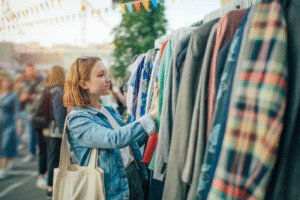
- The word “thrifted” is an adjective that denotes the purchase of an item secondhand, typically from a thrift store or charity shop, or through a resale marketplace. While the word thrifted can sometimes have a negative connotation, it usually describes something unique, fashionable, and sustainable.
Examples in Context
- Thrifted jeans → Denim secondhand, and potentially vintage or unique.
- Thrifted bags → Handbags that are pre-owned, possibly even designer, and potentially very rare, that are often sold too low below their estimated value.
- Thrifted sneakers → Footwear bought secondhand, often limited edition or lightly worn.
Thrifted vs. Vintage: What’s the Difference?
Although people often confuse the two, thrifted and vintage are not the same. Here’s how they differ:
| Aspect | Thrifted | Vintage |
| Definition | Items purchased secondhand from thrift stores, donation centers, or resale apps. | Clothing or goods that are at least 20 years old, often older, and recognized for their historical or cultural value. |
| Source | Primarily donations from the public, charity drives, or bulk overstock. | Curated from private estates, collections, auctions, or specialty sellers. |
| Age of Items | Can be recent or old; no age requirement. | Must be 20+ years old (e.g., anything produced before 2001 is now considered vintage). |
| Curation | Thrift stores offer a wide mix of clothing, furniture, books, and home goods with little filtering. | Vintage shops are highly curated, run by collectors with expertise in history, fashion, and authentication. |
| Pricing | Usually lower, as items are priced for accessibility and quick turnover. | Higher, reflecting rarity, condition, and curation efforts. |
| Shopping Experience | A “treasure hunt” – customers dig through racks to find gems. | Easier to browse; vintage sellers do the digging, cleaning, and presenting for buyers. |
| Community Impact | Often tied to charities or nonprofits, supporting local causes. | More focused on preservation of style, history, and culture than direct charity. |
The Pros and Cons of Thrifting
There’s good and bad to any shopping behavior, and thrifting is no exception. Many people find that the positives of thrifting outweigh the negatives, but either way, you should be aware of both before jumping in.
Pros of Thrifting
Cost
One of the biggest reasons for thrifting is the cost. The secondhand stores often offer decent clothing, accessories, and even name-brand products for very low prices. A thrifting approach is effective for a cash-strapped student, a parent buying for growing kids, or someone starting out dressing for work. Thrifting allows your budget to go farther while still looking like a million bucks.
Eco-friendly
Thrifting is good for the planet. This helps to reduce the amount of clothing being produced, therefore reducing pollution from the fashion industry and textile waste in landfills. Buying secondhand also lessens the demand for new clothing, which means fewer virgin natural resources are used to produce things like water and electricity. Every thrifted purchase is a tiny step toward saving the planet!
Individual Style and Self-Expression
Unlike fast fashion, where everyone ends up sporting the same trend, thrift stores provide unique pieces. From vintage jackets that look like they came from the back of a relative’s closet to fun, quirky accessories, thrifted pieces can help you build a wardrobe that is individual to you. It’s a great way to play around with fashion and develop a personal style that stands out!
Supporting Community and Small Business
Many thrift shops are operated by local entrepreneurs or charitable organizations. By shopping there, you’re either supporting a small business or supporting community development, shelters, or disaster relief, to name a few examples. It’s shopping that gives back.
Resale and Returns
Thrifting isn’t just about purchasing – you can also get paid! If you consignment or sell the clothes you no longer wear, you’ll make a little extra cash, recycle your wardrobe, and keep clothing from being wasted. They’re called “circular economies” because nothing is wasted!
Cons of Thrifting
Not Brand New
If wearing second-hand clothes makes you uneasy, then thrifting probably isn’t right for you. While lots of things may be gently used and washed, only a small fraction is brand new and has the tags still attached; so you must observe things closely when you buy.
Overpaying for junk
The popularity of thrifting has attracted cheap fast-fashion brands flooding many stores with these low-quality pieces that look somewhat appealing, but more than likely won’t last. Many newbies take thrift items for almost retail prices, and sadly, they won’t last, so it is critical to learn how to identify quality fabric and construction.
Overconsumption
Since thrift prices are so low, it is easy to overconsume. Many consumers end up with countless hangers of clothes that they never wear. Thrifting only really works for the consumer if you are intentional about it, meaning you like and need things, rather than if everything seems at a “good price.”
Trends
Thrifting your fashion doesn’t mean it is trendy. When you think of styles, they cycle quickly. Many resale shops won’t accept pieces over a couple of years old for consignment. If you intend to resell the thrifted clothing, the life cycle may be quite short.
Thrifting is a fun, eco-conscious shopping method that can be cost-effective, support communities, and find unique pieces! However, it does take time, a good eye for quality, and self-restraint so you do not end up with too much. Whether you prefer thrift stores or regular retail stores is dependent on what is important to you, e.g., affordability and sustainability for some shoppers, while others value convenience and freshness.
How Thrift Stores Price Items
- Condition: Items in great condition (with tags) receive a higher price; items that are heavily worn are usually much cheaper.
- Brand Value: The resale price of high-priced labels or brands is reflected in thrift store pricing.
- Demand & Trends: Some popular styles like vintage Levi’s and Y2K fashion will cost more due to demand.
- Category: Everyday use basics are usually priced cheaper, and higher for categories like coats, bags, or shoes.
- Charity Shops / Stylistically Curated Organization: Charity shops sell items cheaply for volume, while one-time vintage shops sell at higher prices for the quality and stylistic authenticity.
Tips for First-Time Thrifters
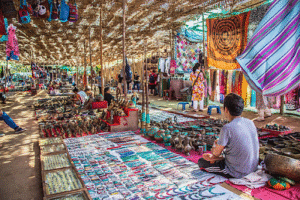
- Be Patient: Thrifting is like a treasure hunt, and you may have to dig to find the special pieces!!
- Check Quality: Make sure to check the stitching, zippers, and fabric quality for wear and tear prior to buying!!
- Experiment with Entire Sections: Don’t just stick to your specific size or[ gender sections, you may find awesome oversized or even unisex options!!
- Set a Budget: Because of the low prices, it is easy to overbuy, so make sure you shop with purpose!!
- Think Creatively: Look for pieces that you can style differently or even upcycle with a little DIY!!
- Sanitize After You Buy: Wash or dry clean thrifted clothing before it goes on your body!!
In conclusion, thrift shopping is about exploring new sources for clothing, understanding pricing, and smart shopping. If first-time thrifters are patient and plan well, they can get fashionable finds that are unique, affordable, and sustainable.
Thrifting vs. Fast Fashion
Fast fashion dominates the retail market worldwide through companies like Shein, Temu, and TikTok Shop, which typically sell affordable, trendy clothes designed to last for the shortest amount of time possible. Inherently, this is a cheap way to consume fashion, but it is cheap at a cost:
Environmental Harm: The U.S. landfilled over 9 million tons of clothing and footwear in 2018 vs. just 1.3 million tons in 1960. Synthetic clothing takes hundreds of years to decompose. And jeans alone use about 2,000 gallons of water to cheap to produce!
Human Harm: Poor pay and lack of safety at the factories where clothing is made is documented in tragedies found in climate-distressed countries for pennies on the dollar.
While thrifting avoids the excessive demand on already worsening fashion production, it keeps clothes in circulation, and when a quality piece is thrifted, it is usually affordable. Stores that are built around donations to help individuals in need, but mostly just recycle unwanted clothes like Goodwill or Salvation Army, and typically thrifted clothes last longer as they ‘traded up’ from fast fashion.
But similarly, there are flaws and challenges to thrifting. Sellers sometimes overprice the thrifted clothes on platforms like Depop and Poshmark, thereby limiting individuals who want to shop with a low-cost option. Especially plus-size individuals, because apparently they fall outside of the demographic of a larger number, and resellers pick up the clothes as oversized fashions to resell. Accessibility is also an issue since thrift shops vary in the amount of resources dedicated to their shops, so not everywhere has thrift stores.
The Indian Scenario
Thrifting is still a new concept in India. Generally, buying secondhand clothing represented an act of necessity rather than style. However, as more consumers become aware of sustainability and Gen Z shows more enthusiasm to purchase secondhand clothing that offers originality and low prices, thrift in India is seeing some growth with all the online thrift stores on Instagram and resale platforms. While giants of fashion ecommerce like Myntra and Flipkart will dominate, the move toward thrift in India shows that a growing group of consumers is starting to consume with affordability and awareness in mind.
Thrift Shopping Tips & Best Practices
- Explore: Yard sales, garage sales, and church rummage sales can be hit-or-miss, but when they are good, you can find treasures for a fraction of retail pricing.
- Go Early & Go Often: Professional thrifters stand in line to grab limited fresh arrivals before the store opens. The more often you go, the more likely you are to find a quality item on a visit.
- Try Everything on: Sizing varies quite a bit when thrifted. Sometimes older clothes fit smaller than size, while sometimes a brand has a larger fitting.
- Check brands & quality: Look for designer brands or quality fabrics. If you find a timeless piece that just needs a small repair (like sewing on a button), it may be worth it.
- Check the dressing room racks: Sometimes there are many OTHER “good finds” that get returned to the racks when they didn’t fit someone else.
- Create rapport: Be friendly with the staff. They often give loyal customers a heads-up on special items that come in.
- Try different stores: Some stores in areas where people are affluent or specialty vintage stores may have better quality donations. However, the flip side is that they sometimes have higher prices.
- Look closely: For furniture and decor items, check for structural integrity, water damage, or mold before purchasing. For clothes, check seams, zippers, and stains before purchasing.
- Do your homework: Learn the brand’s marks or any unique identifiers (like etched logos on crystal) that can give you a clue that you may have found a gem.
- Look Everywhere: Not all gems are in the right section. Look in men’s, women’s, kids’, and home goods, you never know what you will find.
- Have a Plan: Go in with a list of items you need. This keeps you on track and avoids “thrift remorse.”
- Use Technology: Apps like Google Lens can help you identify pieces quickly and see if you are getting a good deal.
Challenges & Misconceptions Around Thrifting
Thrift shopping is dirty
When people are worried about wearing used clothes, it’s true that many people have tried on items for sale at retail, and many are returned after being previously worn. When thrift shopping, the main thing is to wash or disinfect your treasure before wearing it.
Thrift shopping is too competitive
Yes, the options can feel insurmountable because there is typically only one of each item in a thrifting environment; however, there is nothing about it that needs to be overwhelming. Head in there with an open, flexible list of must-haves. Treat it like a treasure hunt, and maybe even find a buddy to join you for fun.
Thrift stores do not carry plus sizes
This is simply not the case; there are people of all sizes who donate clothing. This means that most thrift stores carry items of all shapes and sizes, even plus sizes. If you are very petite or larger, you may have to dig for your treasures, but you will be able to find great pieces.
Secondhand means out of style
While many thrift stores carry items that are well past their prime, you can also find summer’s latest trending styles, vintage, and even designer pieces that meet the current styles. Fashion is cyclical, so it shouldn’t be hard to find a classic staple or an item from a retro period that is on trend!! There are so many items that were donated over the last number of decades, which makes thrifting a great way to find items you love!
Future of Thrifting
The future of thrifting is looking brighter than ever, as technology, consumer demand, and sustainability come together.

- Digital Thrift Boom: Online resale apps like Depop, Poshmark, and ThredUp have normalized secondhand shopping and pushed thrift into the mainstream. Thrifting is now easier, faster, and more accessible to a global audience than ever before, with AI-generated curation and personalized recommendations.
- Luxury Resale Growth: Platforms like The RealReal and Vestiaire Collective have reshaped secondhand fashion by selling authenticated designer pieces. This luxury resale movement engages the fashion-forward shopper and strengthens the connection of sustainability to high fashion.
- Shift Toward Circular Fashion: Thrifting is an integral part of the circular economy that values clothes as reusable, repairable, and recyclable. With this movement, as brands and customers embrace this new reality, resale and upcycling will lead the way for sustainable fashion.
Conclusion :
Thrifting is so much more than purchasing used clothing. It is about how to reuse garments, reduce waste, and showcase personal style. When I thrift or shop secondhand, I think of not only the affordable aspect of buying clothing, but also the creativity that purchasing thrifted and, of course, the sustainability and desire to be more environmentally friendly in our consumption habits. The culture of thrifting aligns with unique clothing, the opportunity to express yourself, and the conscious decision to be more active in the consuming cycle.
If you haven’t thrifted yet, you should give it a try. Whether you are at your local thrift store, flea market, or shopping on an online resale platform, secondhand shopping offers you the opportunity to save money, find a one-of-a-kind piece, and make a small but positive change to the sustainability of the planet. Thrifting is where affordably meets sustainability, and the style comes naturally.

